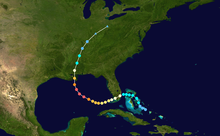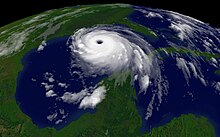Effects of Hurricane Katrina in Alabama
 Katrina shortly after making a third and final landfall in Mississippi. | |
| Meteorological history | |
|---|---|
| Duration | August 29–30 |
| Category 1 hurricane | |
| 1-minute sustained (SSHWS/NWS) | |
| Highest winds | 75 mph (120 km/h) |
| Lowest pressure | 928 mbar (hPa); 27.40 inHg |
| Overall effects | |
| Fatalities | 2 indirect |
| Damage | $1.5 billion (2005 USD) |
| Areas affected | Alabama |
Part of the 2005 Atlantic hurricane season | |
The effects of Hurricane Katrina in Alabama were damaging and deadly. On August 29, Hurricane Katrina made two landfalls in Louisiana and Mississippi. Katrina caused many impacts due to its large wind field across the southeast, including places like Alabama.
Background

| Hurricane Katrina |
|---|
 |
| 2005 Atlantic hurricane season |
| General |
|
| Impact |
| Relief |
| Analysis |
| External links |
|
On August 23, Tropical Depression Twelve formed over the southeastern Bahamas. By the morning of August 24, it had strengthened into Tropical Storm Katrina. It then proceeded to become a Category 1 hurricane two hours before making landfall in South Florida on August 25. It weakened over land while moving over southern Florida, but it soon restrengthened after getting into the Gulf of Mexico. On August 27, it strengthened into a Category 3 hurricane, becoming the season's third major hurricane. It then went through an eyewall replacement cycle, weakening the storm a little but causing the hurricane to grow much larger.[1] Once it was over, Katrina got over the waters in the unusually warm Loop Current, causing it to rapidly intensify and reach Category 5 strength in just nine hours, during the morning of August 28. It reached a peak intensity of 175 mph (282 km/h), and a pressure of 902 mbar (26.6 inHg). It then went through yet another eyewall replacement cycle, weakening into a Category 3 hurricane.[2]
Then, it made its second landfall near Buras-Triumph as a Category 3 hurricane with 125 mph (201 km/h) winds and a pressure of 920 mbar (27 inHg). After crossing over southeastern Louisiana and the Breton Sound, it made a third and final landfall around the Louisiana-Mississippi border, with winds of 120 mph (190 km/h). Even after making landfall, it kept its strength as a hurricane almost 150 mi (240 km) inland, before becoming a tropical storm near Meridian, Mississippi. It weakened into a tropical depression near Clarksville, Tennessee, and later got absorbed by a cold front in the Great Lakes region.[1]
Preparations
On August 27, at 21:00 UTC, a hurricane watch was issued for the entire Alabama coastline. By August 28, at 3:00 UTC, this was upgraded to a hurricane warning. However, on August 29, at 21:00 UTC, it was downgraded to a tropical storm warning, and the warning was later discontinued on August 30, at 3:00 UTC.[1]
Impacts
Wind gusts up to 80 mph (130 km/h) were reported in the southeastern part of Alabama, downing trees and power lines.[3] Four tornadoes formed in Central Alabama - two EF0s and two EF1s. These tornadoes caused damage to trees and multiple mobile homes.[4] On Dauphin Island, a storm surge of 15 ft (4.6 m) moved ashore, destroying over 350 houses.[5] Only 50 have since been rebuilt.[6] In Mobile, a storm surge of 11.45 ft (3.49 m) moved ashore, while in Bayou La Batre, a storm surge of 12 – 14 feet was pushed ashore.[7] As a result of the storm surge, an oil rig under construction along the Mobile River was dislodged, sending it down the river where it struck the Cochrane Bridge. Another offshore oil rig washed up on the beaches of Dauphin Island. Two indirect deaths were reported after a fatal car accident during the storm.[1] Part of Battleship Parkway, or "The Causeway", which connects parts of Mobile Bay together, collapsed, causing a temporary closure.[8] Sustained winds of 73 mph (63 kn) were reported on Dauphin Island, while a gust of 102 mph (89 kn) was also reported on Dauphin Island.[9] Much of Alabama west of Interstate 65 received 2–4 inches (5.1–10.2 cm) of rain. Peak rainfall was 4.82 inches (12.2 cm) in Hamilton, Alabama.[10] Over 656,000 customers in Alabama lost power,[11] causing it to have, at the time, the second most power outages for a storm in Alabama history behind only Hurricane Ivan.[12]
Aftermath
As a result of the flooding in Mobile, a curfew from dusk to dawn was implemented.[7] Around a week after Katrina hit Alabama, FEMA approved 5.2$ million into disaster aid to over 3,000 households in Alabama. Almost 550 truckloads with of supplies also arrived in Alabama from logistical centers across the southeast.[13]
References
- ^ )
- ^ "CU-Bolder Researchers Chart Katrina's Growth in Gulf of Mexico". University of Colorado at Boulder. September 15, 2005. Archived from the original on 2009-03-01. Retrieved December 21, 2021.
- ^ NWS Birmingham, Alabama (August 29, 2005). "Hurricane Katrina - August 29, 2005". NWS. Retrieved December 21, 2021.
- ^ NWS Birmingham, Alabama (August 29, 2005). "Hurricane Katrina - August 29, 2005 Tornadoes". NWS. Retrieved December 21, 2021.
- ^ Hendricks, Mario (August 30, 2010). "Alabama coastal residents remember the impact of Katrina". WSFA 12 News. Retrieved December 21, 2021.
- ^ Hendricks, Mario (August 30, 2010). "Alabama coastal residents remember the impact of Katrina". WSFA. Retrieved June 4, 2022.
- ^ a b Morgan, Leigh (May 18, 2019). "Hurricanes that Alabama may never forget". AL.com. Retrieved December 22, 2021.
- ^ Daker, Susan (August 31, 2005). "Storm surge wipes out much of the causeway". AL.com. Retrieved December 24, 2021.
- ^ Jeffery Merlin, Ray Ball, and Gary Beeler (August 2005). "Hurricane Katrina - August 2005". weather.gov. Retrieved December 24, 2021.
{{cite news}}: CS1 maint: multiple names: authors list (link) - ^ "Hurricane Katrina - August 29, 2005". NOAA. Retrieved June 4, 2022.
- ^ "Alabama power outage statewide". CNN. Retrieved June 4, 2022.
- ^ "OFFICE OF ELECTRICITY DELIVERY AND ENERGY RELIABILITY (OE) U.S. DEPARTMENT OF ENERGY Hurricane Katrina Situation Report #11" (PDF). US Department of Energy. August 30, 2005. Retrieved June 4, 2022.
- FEMA. September 8, 2005. Retrieved December 20, 2021.
